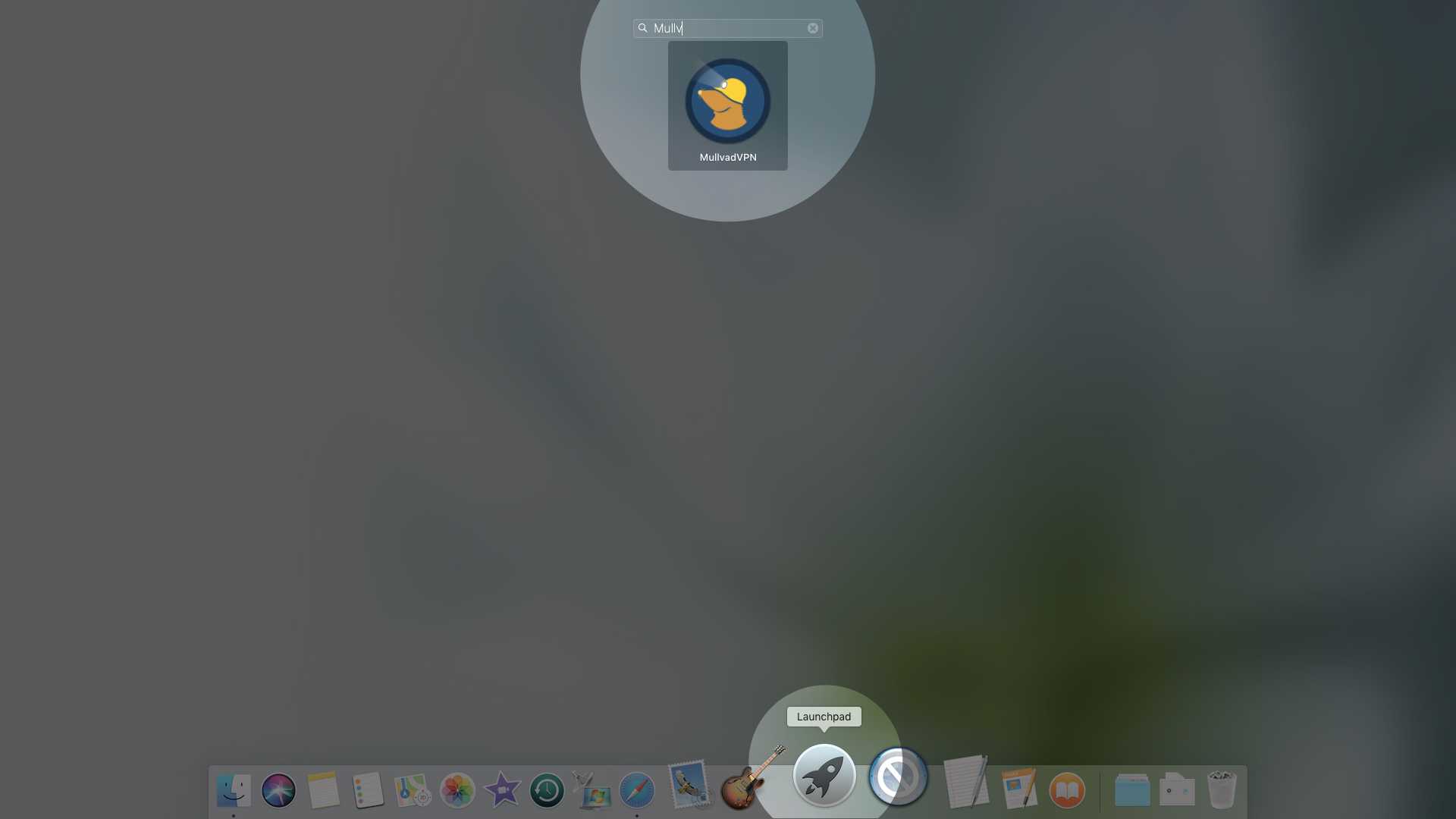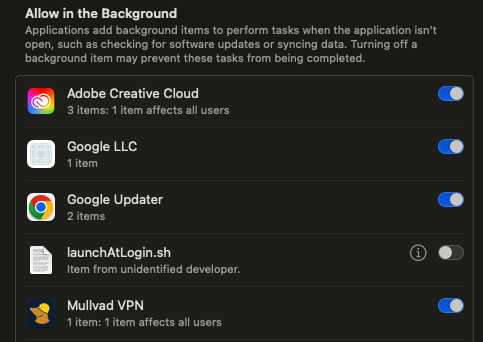Install app on macOS
Mullvad app Installation macOS Desktop
Dernière mise à jour:
This guide explains how to install and uninstall the Mullvad VPN app for macOS.
What this guide covers
- Installation requirements
- Download and install the Mullvad app
- - Troubleshooting installation
- Start the Mullvad app
- - Troubleshooting Mullvad
- -- Prevent other apps from setting the DNS
- -- Connecting to Mullvad system service (macOS 13 Ventura)
- -- The Mullvad padlock icon disappears
- -- Unable to use the Internet after disconnecting Mullvad
- Disable Location Services in macOS
- Uninstalling the Mullvad app
Installation requirements
- macOS 13 (Ventura) or newer.
- If you have an older version of macOS (10.10-10.15) then you can use Tunnelblick instead.
The Mullvad app is Apple Silicon native since version 2021.4 and works on both Intel Macs and M1/M2 Macs.
Download and install the Mullvad app
- Download the latest version of the Mullvad app from the Apps page on our website.
- Open the folder that you downloaded the installer to and double-click on MullvadVPN-xxxx.x.pkg ("xxxx.x" is the version number).
- If you get a message that says "Installer would like to access files in your Downloads folder" then click on OK.
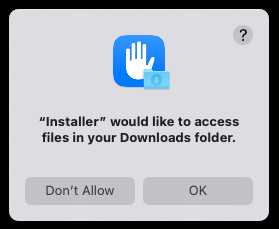
- After the installation is done there should be a message that says:
"Background Items Added - "Mullvad VPN" added items that can run in the background. You can manage this in Login Items Settings".
Troubleshooting installation
Error: "The installation failed"
An error can occur during installation if the installer does not have access to the folder which you downloaded Mullvad to. This can also happen if you are using Dropbox or Avast Security. If you have this problem then follow these steps:
- Open the System Settings app and click on Privacy & Security in the left side.
- Click on Full Disk Access.
- In the list you should see Installer. Click on the button to enable full disk access. If you do not see "Installer" then click on the + icon in the bottom left corner. Click on Applications in the left column and then select Macintosh HD in the location drop-down menu in the top. After that select System > Library > CoreServices > Installer.

- Start the Mullvad installer again. Now it should work.
- After the installation is done go back to the System Settings app and turn off full disk access for Installer again.
Error: "cannot be opened because it is from an unidentified developer"
If you get the message that the installer "cannot be opened because it is from an unidentified developer" then right-click on the installer and select Open.
You can also open the System Settings app and click on Privacy & Security in the left column. Then scroll down to the bottom. In the middle you should then see a message that says "MullvadVPN-2023.4.pkg was blocked from use because it is not from an identified developer". Click on the button that says Open Anyway.

Start the Mullvad app
Launch the Mullvad app from the Launchpad, or find it in the Applications folder.
The first time you start the app, a window may pop up. Click on Open to continue.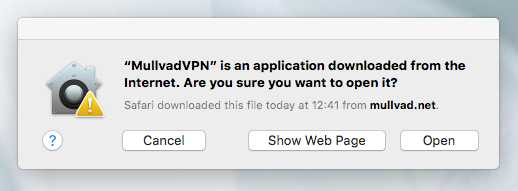
Once the app starts, you will see an icon of a red padlock in the menu bar. Click on the padlock to display the app's login screen. Enter your Mullvad account number and then click on Secure my connection.
Read more about how to use the Mullvad app in the guide Using the Mullvad VPN app.
Troubleshooting Mullvad
Prevent other apps from setting the DNS
The Mullvad app needs to set the system DNS to prevent DNS leaks. If there is a conflicting app that also sets the DNS then Mullvad will block the Internet and show the message Unable to set system DNS server. If this happens try the following.
1. Turn off "Calls from iPhone" in the FaceTime app preferences, and restart the computer.
2. Uninstall any app that sets the DNS or blocks connections, for example the following:
- Little Snitch
- Lulu
- Tailscale
- TripMode
- Cloudflare Warp
- Adguard
- NextDNS
- Freedom.to
- Ubiquiti software
- T-Mobile DIGITS
3. Go to the Mullvad app settings > VPN settings and enable Enable IPv6. If it's already on then try to turn it off instead.
4. Disable IPv6 on your Mac by opening the Terminal app and entering one of the following commands, depending on which network type you use:
sudo networksetup -setv6off Ethernetsudo networksetup -setv6off Wi-Fi
In case you need to restore IPv6 connectivity again use one of these commands:
sudo networksetup -setv6automatic Ethernetsudo networksetup -setv6automatic Wi-Fi
Connecting to Mullvad system service (macOS 13 Ventura and newer)
When you click on the red padlock icon in the macOS menu bar the Mullvad app may show this:
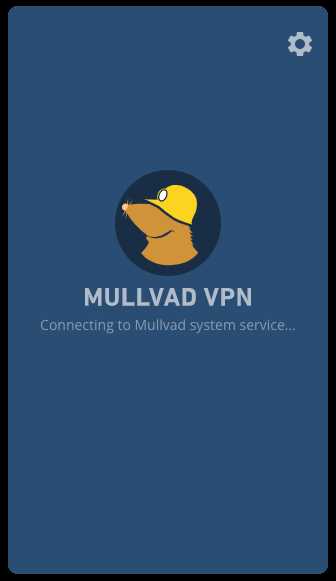
To fix this open the System Settings app and go to General > Login items. Under "Allow in the Background" you should find Mullvad VPN. Make sure that is enabled.
If it doesn't help then open the Terminal app and run this command:
sudo launchctl load /Library/LaunchDaemons/net.mullvad.daemon.plist
If it asks for a password then use your Mac login password (it will not show the password as you type it).
The Mullvad padlock icon disappears
If you are using a MacBook with a camera notch then the menu bar icons will get hidden if you have too many icons. In this case you would have to quit other apps which has an icon on the menu bar, or disable some system icons. Keep in mind that menu bar icons can only occupy the space from the right corner to the notch in the middle.
Unable to use the Internet after disconnecting Mullvad
- Make sure that you have not enabled Lockdown mode in the Mullvad app settings.
- Try to turn off and on your Wi-Fi, or unplug and plug in your network cable.
- macOS Ventura: Open the macOS System Settings app and click on Network and then click on the connnected network. Then click on Details... and then DNS. Click on the plus button and add a new DNS server like for example 1.1.1.1. Then click on Ok.
Disable Location Services in macOS
To prevent apps from requesting your location using Wi-Fi or GPS you can turn off Location Services.
- Open the System Settings app.
- Click on Privacy & Security in the left column.
- Click on Location Services.
- Turn off Location Services with the option button.
Uninstalling the Mullvad app
You can uninstall the app in two different ways.
Uninstall option 1
To uninstall the Mullvad app and also remove the local log files, cache and settings do the following.
- Make sure that you have written down your Mullvad account number.
- Open the Terminal app and run the following command:
/Applications/Mullvad\ VPN.app/Contents/Resources/uninstall.sh - If it asks for a password then use your login password (it will not show the password as you type it).
- Restart the Mac.
Uninstall option 2
This option only uninstalls the app. The local log files, cache, and settings will remain on your device.
- Open the macOS Applications folder.
- Find the Mullvad VPN app and drag it to the trash.
- Lastly, choose Finder > Empty Trash.
